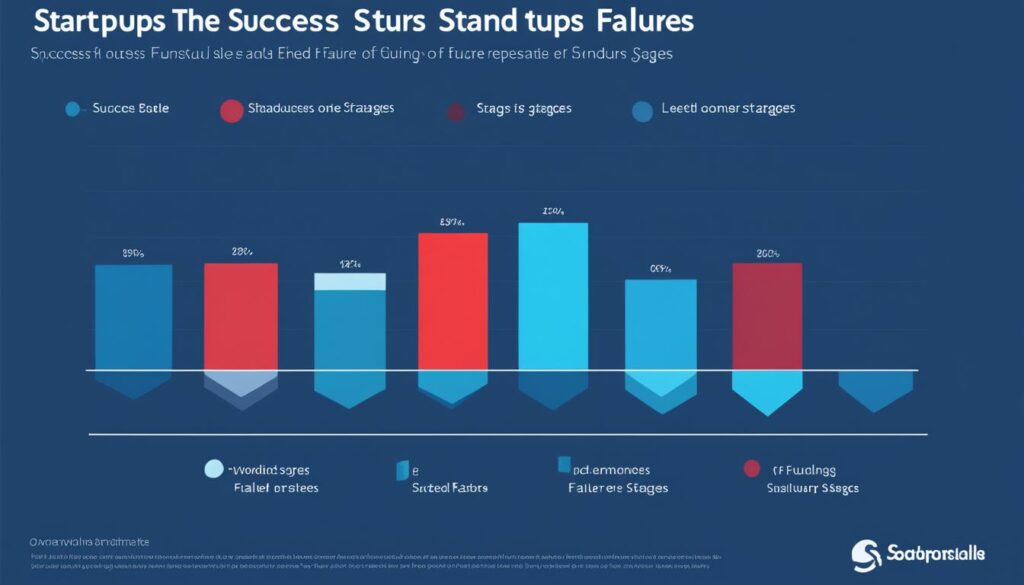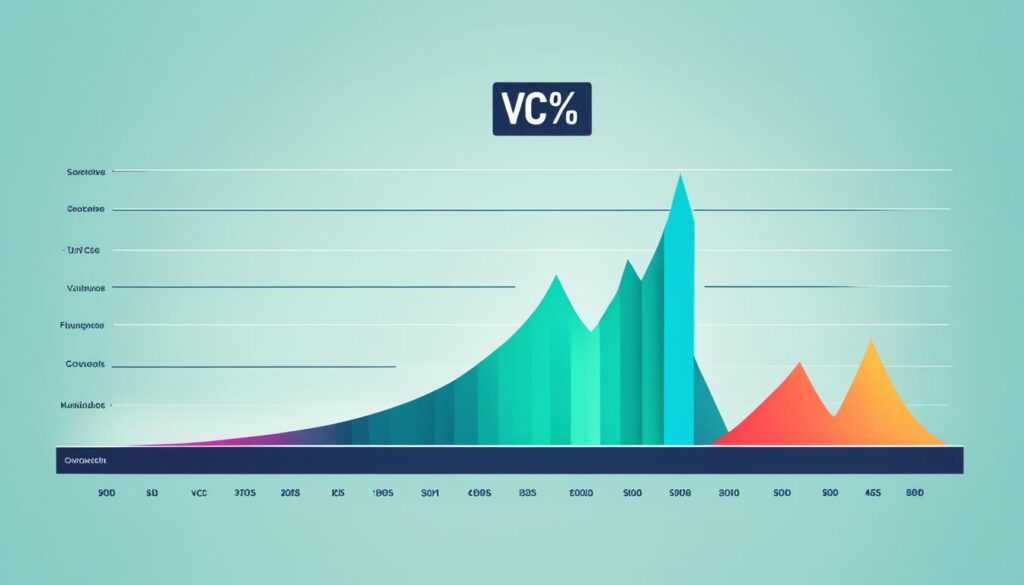When it comes to the world of venture capital (VC), one burning question often arises: what percent of VC firms actually fail to deliver returns for their investors? The venture capital industry plays a crucial role in funding and supporting innovative startups, but as the saying goes, “the startup graveyard is littered with the remains of companies that couldn’t make it.” So, let’s dive into the statistics and explore the factors that contribute to the high failure rates in the VC landscape.
Key Takeaways
- According to Harvard Business School, the failure rate of VC-backed startups is notoriously high, with estimates suggesting that 25-30% of venture capital firms fail to return investor capital.
- The startup ecosystem as a whole experiences extremely high failure rates, with over 90% of all startups failing overall.
- Startups that receive VC funding face the highest failure rates during the early stages, particularly in the pre-seed and Series A funding rounds.
- The failure of VC-backed startups can have significant financial implications for the investors involved, with industry research suggesting that three-quarters of startups backed by venture capital never end up returning the cash to investors.
- To mitigate the risks of VC firm failures, industry experts recommend a focus on thorough due diligence and risk management practices.
Introduction to VC Firm Failure Rates
Venture capital plays a critical role in funding and supporting innovative startups, providing them with the capital and resources needed to grow and scale. However, the startup ecosystem is highly competitive, and VC firms face numerous challenges in identifying and investing in successful ventures.
Venture Capital’s Role in Startup Ecosystem
VC firms serve as a vital source of funding for emerging businesses, offering not only financial support but also strategic guidance and industry expertise. They play a crucial part in nurturing the startup ecosystem, helping to transform innovative ideas into thriving enterprises.
Challenges Faced by VC Firms
Despite their importance, VC firms must navigate a complex landscape fraught with risks and uncertainties. From identifying promising startups to managing portfolio performance, these firms encounter a range of obstacles that can impact their overall success and the returns they deliver to investors.

Percentage of VC Firms That Fail
According to industry estimates, around 25-30% of venture capital firms fail to return investor capital. This means that for every 10 VC-backed startups, approximately 3 or 4 will fail completely, while only 1 or 2 will produce substantial returns for their investors.
Factors Contributing to VC Firm Failures
The high failure rate of VC firms can be attributed to a variety of factors, including the inherently risky nature of the startup ecosystem, the difficulty in accurately predicting the success of early-stage ventures, and the intense competition for the most promising investment opportunities.

Additionally, VC firms may struggle with ineffective due diligence processes, poor portfolio diversification, and a lack of industry expertise or domain-specific knowledge. The fast-paced, constantly evolving nature of the tech industry can also make it challenging for VC firms to stay ahead of market trends and identify the next big disruptive innovation.
What percent of VC firms fail?
Determining the exact percentage of venture capital (VC) firms that fail is notoriously challenging, as the data can be inconsistent and dependent on various factors. The failure rate can vary significantly depending on the stage of the startup, the industry, and other market conditions.
Difficulty in Pinpointing Exact Figures
The venture capital industry is complex, with a wide range of players, investment strategies, and portfolio companies. This makes it difficult to capture a definitive failure rate across the entire industry. Factors such as the investment horizon, the level of diversification, and the investment thesis of individual VC firms can all impact their ultimate success or failure.
Estimates Based on Industry Research
While an exact figure remains elusive, industry research and reports have provided estimates on the failure rates of VC-backed startups and the implications for the firms that invest in them. According to Harvard Business School, the failure rate of VC-backed startups is notoriously high, with estimates suggesting that 25-30% of venture capital firms fail to return investor capital.

These estimates provide a general sense of the challenges facing the VC industry, but the reality on the ground can be more nuanced. Factors such as the stage of the startup, the industry, and the investment approach of the VC firm can all play a role in determining the likelihood of success or failure.
Startup Failure Rates and VC Involvement
The startup ecosystem as a whole is plagued by extremely high failure rates, with over 90% of all startups failing overall. This includes a startling 20% failure rate within the first year and a staggering 50% by the end of year 5.
High Failure Rates for VC-Backed Startups
The failure rates for startups backed by venture capital are particularly concerning. While VC firms play a critical role in funding and supporting innovative companies, the majority of their investments ultimately do not pan out. Industry research suggests that three-quarters of VC-backed startups never end up returning the initial capital to investors.
Reasons for Startup Failures
The high failure rates observed in the startup ecosystem can be attributed to a variety of factors, including fierce competition, lack of market fit, funding challenges, managerial missteps, and the inherent risks associated with innovative, disruptive business models. Navigating the complexities of launching and scaling a new venture often proves to be an arduous task, even for the most promising startups.

Stages of VC Funding and Failure Rates
Startups that receive venture capital (VC) funding face varying levels of failure rates across different stages of the funding lifecycle. The pre-seed and Series A stages typically experience the highest failure rates, while later funding rounds see a gradual decrease in the risk of startup failure.
Pre-Seed and Series A Failures
Around 60% of startups that raise pre-seed funding fail to make it to the next stage, the Series A round. This is largely due to the inherent uncertainty and challenges associated with the early stages of a startup’s development, such as establishing product-market fit, building a viable business model, and gaining initial traction.
Similarly, approximately 35% of startups that secure Series A funding fail to raise a Series B round, as they struggle to scale their operations and demonstrate continued growth potential to investors.
Series B and Beyond: Lower Failure Rates
As startups progress through the funding stages, the risk of failure begins to decline. The chance of failing for a startup post Series B is about 1%, as these companies have typically established a strong market presence, a scalable business model, and a track record of success that makes them more attractive to investors.
However, it’s important to note that even with this decrease in failure rates, the overall startup ecosystem remains highly competitive and uncertain. Continued innovation, strong execution, and the ability to adapt to changing market conditions are crucial for startups to navigate the various funding stages and increase their chances of long-term success.

Impact of VC Firm Failures
The failure of venture capital-backed startups can have significant financial implications for the investors involved. According to industry research, a staggering three-quarters of startups backed by venture capital never end up returning the cash to investors, while an estimated 30-40% of investors lose their entire initial investment.
Financial Implications for Investors
The high failure rate of VC-backed companies can be devastating for the investors who have poured their capital into these ventures. When a startup fails to achieve the expected growth and returns, it not only results in the loss of the initial investment but also deprives investors of the potential upside that could have been realized from a successful exit or acquisition.
Consequences for Startup Ecosystem
The impact of VC firm failures extends beyond just the financial losses for individual investors. The failure of prominent VC-backed startups can also have broader consequences for the overall startup ecosystem. It can erode investor confidence, making it more challenging for promising young companies to secure the funding they need to grow and innovate. This, in turn, can stifle the development of new technologies and business models, ultimately slowing the pace of economic progress.

Strategies for Mitigating VC Firm Failures
In the ever-evolving venture capital landscape, where the risk of firm failures looms large, industry experts emphasize the importance of adopting robust strategies to mitigate these challenges. Two key approaches stand out as crucial in optimizing the success of VC investments:
Due Diligence and Risk Management
Thorough due diligence and rigorous risk management practices are essential in identifying and supporting viable startups. VC firms must carefully vet the management teams, evaluate market potential, and closely monitor the performance of their portfolio companies. By meticulously assessing the risks and opportunities associated with each investment, VC firms can make more informed decisions and enhance the likelihood of successful outcomes.
Portfolio Diversification
Diversifying the investment portfolio is a time-tested strategy for managing the inherent risks in the venture capital industry. By spreading their capital across a range of startups, VC firms can reduce their exposure to the failure of any single venture. This approach not only helps mitigate the financial impact of individual failures but also enhances the overall resilience of the VC firm’s investment strategy.
| Strategy | Key Benefits |
|---|---|
| Due Diligence and Risk Management |
|
| Portfolio Diversification |
|
By implementing these strategies, VC firms can navigate the challenges of the startup ecosystem more effectively, minimizing the risks of firm failures and maximizing the potential for sustainable growth and profitability.

Future Outlook and Trends
The venture capital landscape is constantly evolving, with new trends and innovations emerging that may shape the industry’s future. As the startup ecosystem continues to adapt to the changing market conditions, VC firms are exploring novel investment models and strategies to stay ahead of the curve.
Evolving VC Landscape
Despite the recent slump in VC investment, industry experts anticipate a rebound in the coming years. At the end of Q1 2024, the VC industry’s dry powder, or uninvested capital, reached a record-high surplus of over $300 billion, signaling a potential surge in future funding activities.1 Additionally, while VC-backed deals in the US declined in 2023, the first quarter of 2024 saw a 14% increase in venture funding for American and Canadian companies, indicating a potential resurgence in investment appetite.
Emerging Investment Models
As the startup ecosystem evolves, VC firms are exploring new investment models to capitalize on emerging trends. One such trend is the growing interest in sustainable and socially responsible startups. A search for ‘sustainable startups’ on AlphaSense yielded over 67,000 documents, with an upward trend observed over the last 90 days, suggesting increased investor focus on this sector.1 Additionally, the ongoing digitization of the investment process, with the rise of online platforms and crowdfunding models, may continue to disrupt traditional VC funding approaches.
While the venture capital industry has faced its share of challenges in recent years, the future outlook remains promising. As VC firms adapt to the evolving landscape, new investment models and emerging trends may pave the way for a more diverse and resilient startup ecosystem in the years to come.

Conclusion
The venture capital industry plays a critical role in funding and supporting innovative startups, but it is also plagued by high failure rates. Estimates suggest that 25-30% of VC-backed companies fail to return investor capital, with the highest failure rates occurring in the early stages of funding, as evidenced by the staggering statistics on startup failure rates.
Despite the challenges, the venture capital landscape continues to evolve, with new investment models and emerging trends that may shape the industry’s future. As the startup ecosystem becomes increasingly competitive, VC firms must focus on thorough due diligence, portfolio diversification, and risk management strategies to mitigate the risks of failure and deliver sustainable returns to their investors.
Ultimately, the success of the venture capital industry is closely tied to the health and growth of the startup ecosystem. By continuing to support innovative entrepreneurs and minimizing the impact of VC firm failures, the industry can play a vital role in fostering a thriving and dynamic business environment that drives economic progress and social impact.
